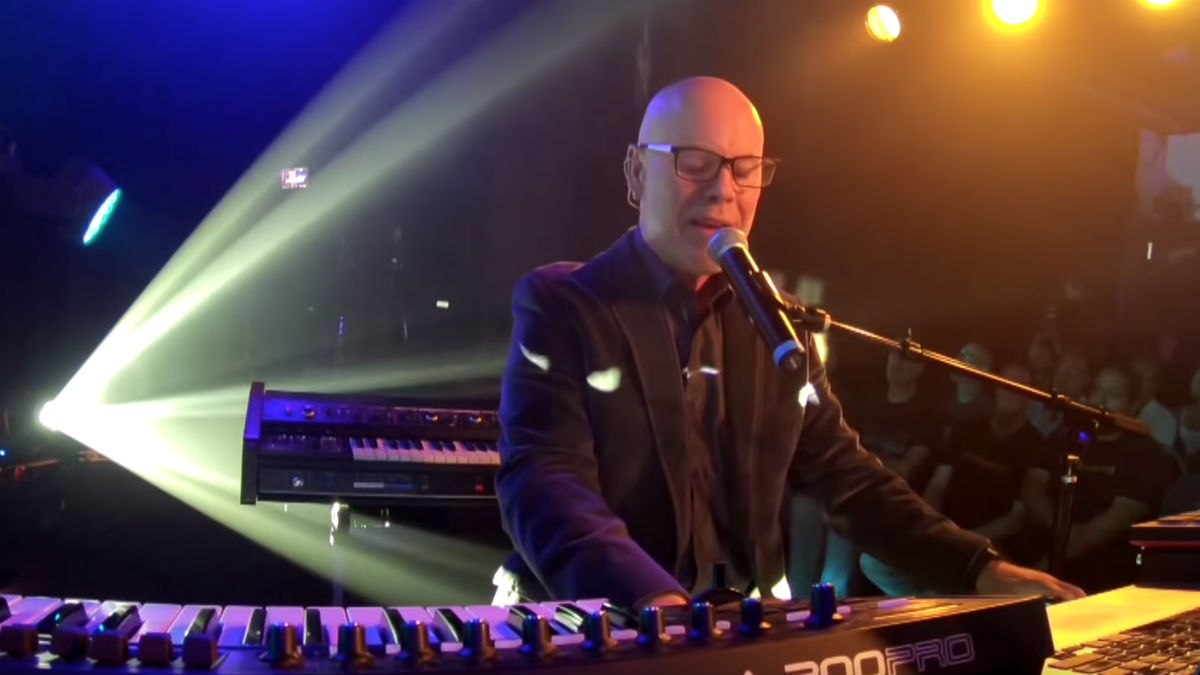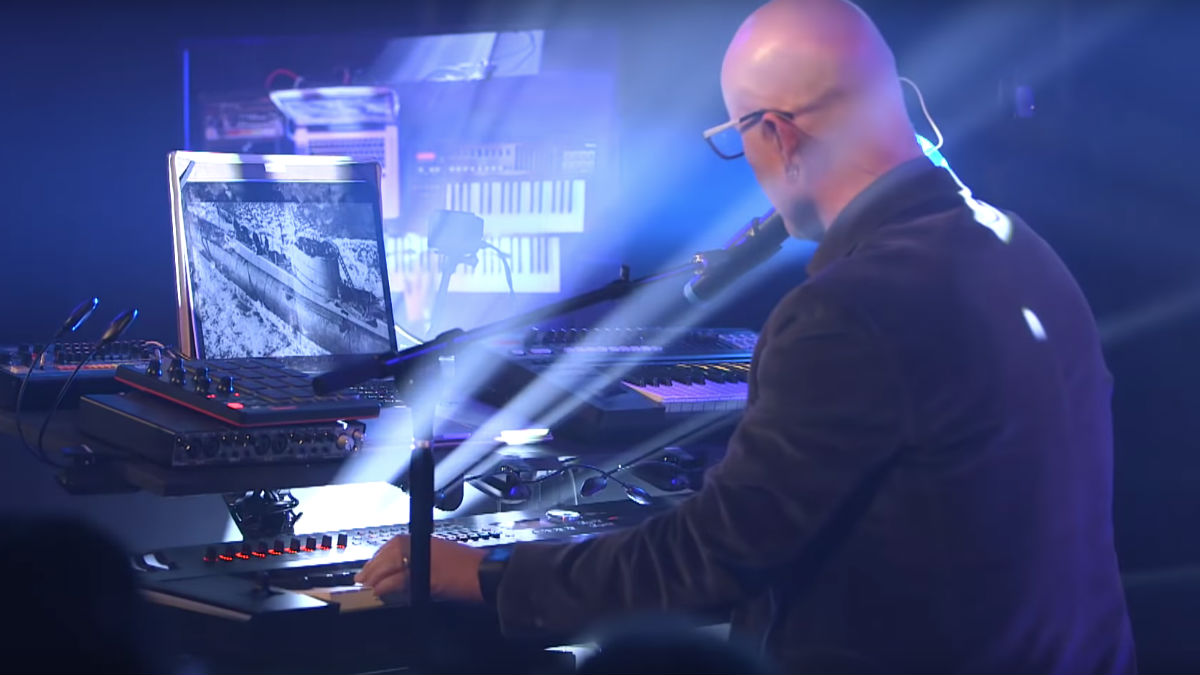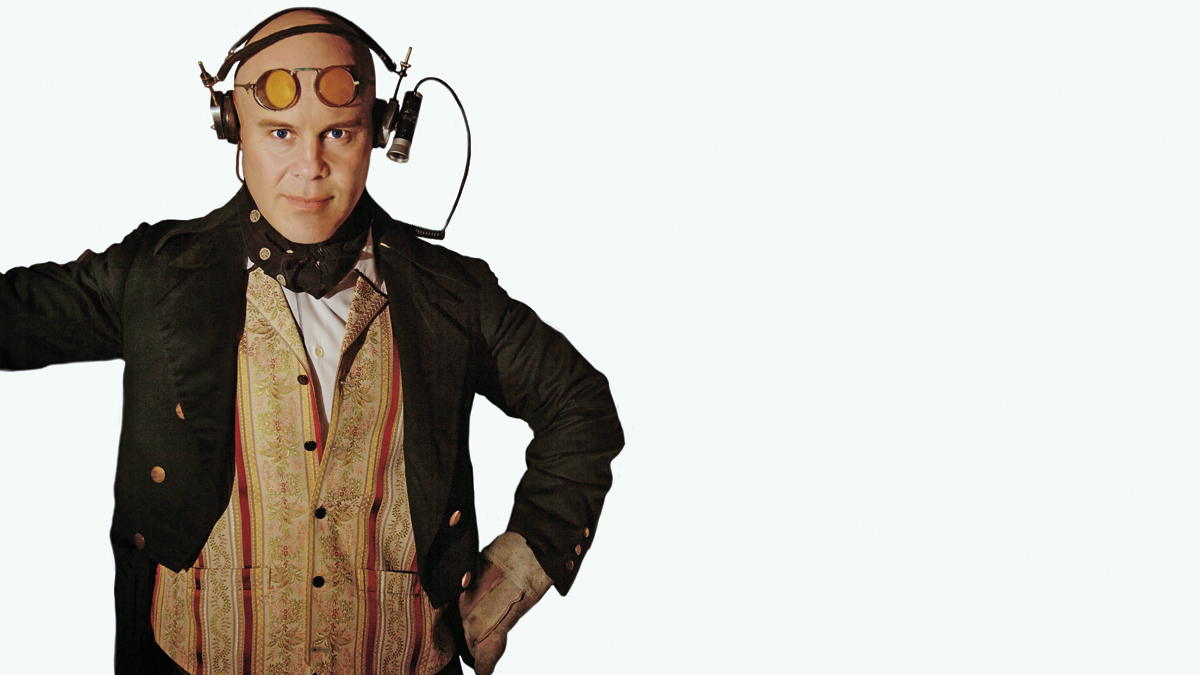Thomas Dolby: “I’m a problem solver. I treat problems as creative opportunities”
A head firmly in Roland’s Cloud

While a laptop on stage is not an uncommon site these days, most performers try to minimise the screen’s involvement in the show in the eyes of the audience. If you can spot the computer at all, it’s usually off to the side, lid half-closed. Even complex pop shows with synced visuals and lighting tend to usher the laptop off-stage, safe from any sweat or beer damaging it’s fragile components.
But new wave star Thomas Dolby is taking a different approach on his current tour, putting the laptop front and centre and giving the audience a closer look into what’s going on under the hood.
Kicking off his tour with a show live-streamed from Roland’s newly opened Los Angeles Artist Relations Centre, Dolby’s stage setup was made up of a laptop with several MIDI controllers, Roland’s TR-08 Boutique drum machine, and most importantly, several models of Cloud instruments, all at the ready.
The show would feature Dolby building the tracks up, one layer at a time, utilising several Roland Cloud instruments in each song. The show is the first of many events that Roland has planned for the Cloud community, according to VP of Marketing Paul McCabe.
“In this moment, Roland Cloud is the world’s finest collection of virtual synthesizer instruments available through an affordable subscription,” McCabe said, “but our vision for the near future includes elements of community, education, enhanced streaming performances, and more. Thomas Dolby Live in Roland Cloud is the perfect first step in this direction.”
Dolby, whose long and varied career was kicked off in 1982 with the then-foreign sounding single “Blinded By Science”, is no stranger to utilising any means possible to get his story across. He now spends much of his time teaching “Music for New Media” at Johns Hopkins University in Baltimore, where Dolby admits he’s learning as much from the students as they are from him.
We sat down with Dolby after the live-streamed performance in a room packed to the gills of legendary Roland boards to dissect his newfound-take on performance, Roland synthesizers, and balancing teaching with life on the road.
Want all the hottest music and gear news, reviews, deals, features and more, direct to your inbox? Sign up here.
So, today you had your old Jupiter 4 on stage with you. Did you lug that out to shows when you were just starting out?
“Yeah, I did all the time. My first one-man show had a Revox tape recorder and a Kodak slide carousel projecting behind me and I would play along with that. And then I got my PPG 380 System, which had a pair of micro-cassettes for each song. So you would load them in, and wait 52 seconds and there was about a 50/50 chance it would work right! So during that time I would talk to the audience, which is sort of how I got my storytelling chops from, learning how to kill time.”
Obviously, times have changed quite a bit, and you’ve never been one to shy away from embracing those changes, from your use of the Fairlight back in the ‘80s to your early uses of sampling. Today you’re running a large part of your show using Roland Cloud instruments. How did you come across the Roland Cloud Platform?
“So, I’ve been using Roland equipment for a long time, starting with the Boss Dr. Rhythm Drum Machine when I was a busker in the Paris metro in the late ‘70s. My first polyphonic synth was that one that you saw on stage, the Jupiter 4. Just four voices, but I did a lot of my early recording with that.
The downside of all this analogue stuff though, unfortunately, is that it’s heavy, it’s hard to stay in tune, you can lose the presets and things like that
“Then I went up to the JP-8, I had a big rack with some Roland rack gear in it because I needed to combine synths and samples. So, I had this huge rack and then they came out with that one (pointing to a D-50 leaning against the wall), which is basically both in the same instrument.
“The downside of all this analogue stuff though, unfortunately, is that it’s heavy, it’s hard to stay in tune, you can lose the presets and things like that, so I’ve gone more towards doing everything in the laptop these last few years.
“So when the Roland Cloud came along, and I could get most of my favourite Roland synths in a digital form, it was really a godsend to me, because I could revert to some of my signature sounds and bring them into my laptop work as well.”

Do you still use any of your old analogue boards?
“No, I don’t really. They take up a lot of space and my wife wants them out of the house! And sometimes a knob or a fader will go down and that sort of spoils the whole thing for me.
“People get very nostalgic about them but I’m not so hung up on it really. The convenience of a laptop works a lot better for me. And you know they sound maybe marginally better, but context is everything, and I’ve always felt that the part is more important than the sound – it’s how you use it.”
Do you have a favourite Roland Cloud emulation?
“Well, so far I’d say my favourite has been the System-100, because I never had a modular synth myself and patching on it is so easy. It’s so easy to save snapshots and go back, whereas real modular synthesis is more of a journey, a rabbit hole that you go down. So I’ve really enjoyed using that and integrating it into my work.”
This was a bit of a special show for you, as it was streamed live on Facebook right out of Roland’s studio. How different was this show from your normal ones, both in terms of setup and how you approached it?
“I played at Largo, a club in Hollywood, and I played for a couple of hours and the format that I’m doing on this tour allowed the audience to pick the songs that I do. And I deconstruct the songs a bit more than I did at the Roland show.
“I probably did less talking than I do at an average show. I think people appreciate getting a look under the hood, if you’re willing to break it down it terms of the beats that you program, and the chords and melodies and sounds, plus of course the inspiration behind the songs.”
You took a very layered, loop-based approach to building up the songs right in front of the audience. Is that something you’ve always done or did that really start when you got more into using the laptop as a performance tool?
“If you watch me layering and looping these songs, you might think I compose that way but in fact I compose pretty much in my head. And I’ll generally go to the piano first, to work out the chords and melodies, and write some lyrics before I go anywhere near a synth.
I think I’m a bit of an idiot savant in that respect, and the irony is that I’m now teaching at one of the country’s greatest music conservatories
“Having said that, very often I’ve been fooling around with sounds and I come up with something so inspiring that the song comes out of that. For example, I did a song called ‘Wind Power’ with a very early PPG Wavetable synthesizer I had and the wavetables were so bizarre that sometimes you would hold down a note and it would have a rhythm to it, just from scanning through the wavetables.
“I had this one particular song and I just started playing this bass line along with the rhythm of that modulation and it turned into my song ‘Wind Power”, so sometimes you can start with the technical and it turns into a song. Other times, I’ve written songs where, for 10 or 12 years, I’ve never sang a note of them or played them on the keyboard. They’ve just been developing in my mind while I go for a walk, while I am driving, while I’m taking a shower.”
Do you ever have trouble remembering them?
“Luckily, I have a very good memory for music. I went to Austin, Texas a couple of weeks ago and they encourage musicians there, all the time. I was in a bookstore and there was a girl sitting play guitar. She was playing as I walking by and then two or three minutes went by and she came back to the chorus, and I sang a harmony to her chorus. She stopped playing and looked back at me aghast, saying ‘How do you know my song? It isn’t even recorded yet!’ and so on. And I said, well you played that chorus a few minutes ago, and she was completely astounded that I had come up with the harmony in my head like that.”
That’s an incredible skill to have!
“Yes. I’m not a trained musician but I’ve developed my intuitive music skills because I’ve never spent any time reading music, writing it down, writing down chord charts, practising – I never practised in my life really! So I think I’m a bit of an idiot savant in that respect, and the irony is that I’m now teaching at one of the country’s greatest music conservatories and I’m surrounded by students who are concert pianists and virtuoso violinists and they can play, read, or write circles around me.
"But I have something unique to offer them, which is that I’m a problem solver. I treat problems as creative opportunities, and I’ve always done throughout my career. I guess that’s what I have to offer these students.”
If you want to find out more about the Roland Cloud then check out the website, where you will also find a free 30 day trial subscription.


